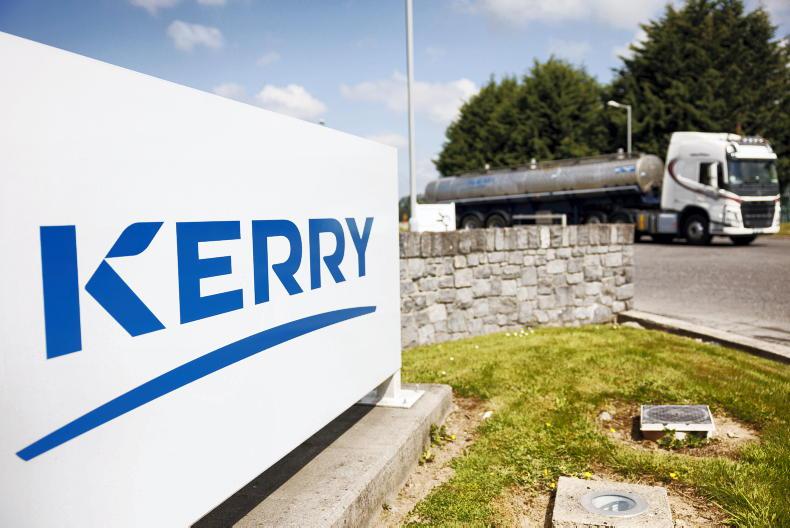Shares in the global ingredients and flavours group touched close to €61 on Wednesday, hitting lows not seen since January 2015.
Over the past 12 months, shares are down 16%. Kerry shares hit record highs of €84.62 in April and are down 28% since these peaks. This sees almost €4bn wiped off the value of Kerry in the past seven months.
With the co-op owning a 13.7% stake in the PLC, its investment has fallen by some €500m in the same period. Farmer shareholders are also estimated to hold a further 30% of the shares in the plc after a number of spin-outs. Individually, they have seen their values fall by a cumulative €1.2bn in recent months.
Why the destruction?
So why such a destruction of wealth? Firstly, Kerry has seen a huge run-up in its share price in the past five years, coming from €24 in 2011. Even three years ago the share price was below €45. Kerry is not unique. On the way up, it did very well, even better that some of its sector competitors. Similarly, in the past six months it has fared a little worse, simply based on the fact that it was trading at extremely high multiples.
These stocks have been trading at relatively high values, particularly over the last two years driven by quantitative easing in the US and the EU, a weaker dollar, low returns from bonds and a general widespread interest by investors in food and ingredient stocks.
Food stocks sell off
In recent months, there has been a marked shift away from food and ingredient stocks to other asset classes. Taking a longer-term 10-year view, Kerry is now trading at more realistic values and back in line with general stock-market indices.
In Kerry’s case, the fear of a hard Brexit and sterling volatility, coupled with the increased possibility of a slowdown in the UK economy, could leave Kerry’s consumer foods division particularly exposed.
The consumer foods business accounts for about 25% of the total group business but contributes a much smaller 16% slice of the profits.
Over the past 10 years, the group has deepened into the more profitable ingredients and flavours businesses. Over the same period, the consumer foods business has been challenged due to a changed grocery retail environment, characterised by deflationary pressures and increased competition.
However, more recently it has been performing much better, with volume growth returning along with margin expansion.
Although it delivers lower margins than ingredients, it is unlikely Kerry would sell its UK consumer foods business. Firstly, it would be hard to find a buyer willing to pay what Kerry might want and, secondly, because of its cash-generating ability for the group.
The bottom line for investors in Kerry is that the company is still valued at over 21 times earnings, which although not at the highs seen recently is more realistic and sustainable in the longer term.
Read more
Kerry's October milk price up 2c/l
Shares in the global ingredients and flavours group touched close to €61 on Wednesday, hitting lows not seen since January 2015.
Over the past 12 months, shares are down 16%. Kerry shares hit record highs of €84.62 in April and are down 28% since these peaks. This sees almost €4bn wiped off the value of Kerry in the past seven months.
With the co-op owning a 13.7% stake in the PLC, its investment has fallen by some €500m in the same period. Farmer shareholders are also estimated to hold a further 30% of the shares in the plc after a number of spin-outs. Individually, they have seen their values fall by a cumulative €1.2bn in recent months.
Why the destruction?
So why such a destruction of wealth? Firstly, Kerry has seen a huge run-up in its share price in the past five years, coming from €24 in 2011. Even three years ago the share price was below €45. Kerry is not unique. On the way up, it did very well, even better that some of its sector competitors. Similarly, in the past six months it has fared a little worse, simply based on the fact that it was trading at extremely high multiples.
These stocks have been trading at relatively high values, particularly over the last two years driven by quantitative easing in the US and the EU, a weaker dollar, low returns from bonds and a general widespread interest by investors in food and ingredient stocks.
Food stocks sell off
In recent months, there has been a marked shift away from food and ingredient stocks to other asset classes. Taking a longer-term 10-year view, Kerry is now trading at more realistic values and back in line with general stock-market indices.
In Kerry’s case, the fear of a hard Brexit and sterling volatility, coupled with the increased possibility of a slowdown in the UK economy, could leave Kerry’s consumer foods division particularly exposed.
The consumer foods business accounts for about 25% of the total group business but contributes a much smaller 16% slice of the profits.
Over the past 10 years, the group has deepened into the more profitable ingredients and flavours businesses. Over the same period, the consumer foods business has been challenged due to a changed grocery retail environment, characterised by deflationary pressures and increased competition.
However, more recently it has been performing much better, with volume growth returning along with margin expansion.
Although it delivers lower margins than ingredients, it is unlikely Kerry would sell its UK consumer foods business. Firstly, it would be hard to find a buyer willing to pay what Kerry might want and, secondly, because of its cash-generating ability for the group.
The bottom line for investors in Kerry is that the company is still valued at over 21 times earnings, which although not at the highs seen recently is more realistic and sustainable in the longer term.
Read more
Kerry's October milk price up 2c/l










SHARING OPTIONS